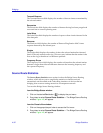
Bridge Spanning Tree 4-39
Bridging
A lower assigned value gives the port a higher Priority when BPDUs are
compared. The allowable range is 0ÑFF hexadecimal (0Ñ255 decimal); the
default is 80 hexadecimal.
Path Cost
Displays the cost that this port will contribute to the calculation of the overall
Root path cost in a ConÞguration BPDU transmitted by this bridge port. You can
lower a portÕs Path Cost to make the port more competitive in the selection of the
Designated PortÑfor example, you may want to assign a lower path cost to a port
on a higher performance bridge. The allowable range is 1 to 65,535.
Designated Cost
Displays the cost of the path to the Root Bridge of the Designated Port on the
LAN to which this port is attached. This cost is added to the Path Cost to test the
value of the Root Path Cost parameter received in ConÞguration BPDUs.
Designated Root
Displays the unique bridge identiÞer of the bridge that is assumed to be the Root
Bridge.
Designated Bridge
Displays the network address portion of the Bridge ID (MAC address/priority
component) for the bridge that is believed to be the Designated Bridge for the
LAN associated with this port.
The Designated Bridge ID, along with the Designated Port and Port IdentiÞer
parameters for the port, is used to determine whether this port should be the
Designated Port for the LAN to which it is attached. The Designated Bridge ID is
also used to test the value of the Bridge IdentiÞer parameter in received BPDUs.
Designated Port
Displays the network address portion of the Port ID (which includes a
manageable priority component) of the port believed to be the Designated Port
for the LAN associated with this port.
The Designated Port ID, along with the Designated Bridge and Port IdentiÞer
parameters for the port, is used to determine whether this port should be the
Designated Port for the LAN to which it is attached. Management also uses it to
determine the Bridged LAN topology.
Topology
This indicates how many times the bridgeÕs Topology Change ßag has been
changed since the device was last powered up or initialized. It also indicates the
time elapsed since the topology last changed. The Topology Change ßag
increments each time a bridge enters or leaves the network, or when the Root
Bridge ID changes.


















